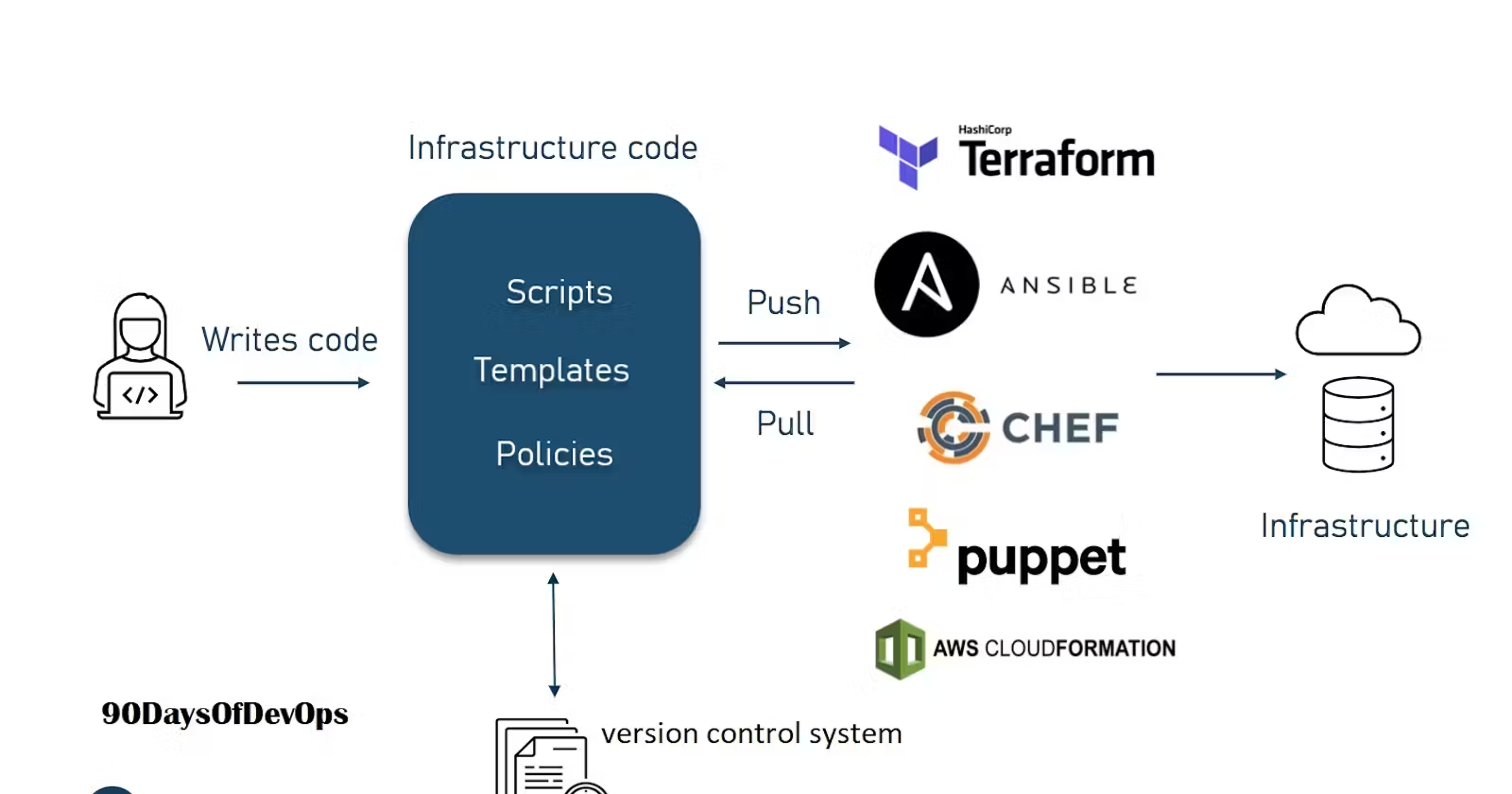DevOps(Day-54): Understanding Infrastructure as Code and Configuration Management
 Biswaraj Sahoo
Biswaraj Sahoo
TABLE OF CONTENTS
What is the difference between IAC and Configuration management?
When it comes to the cloud, Infrastructure as Code (IaC) and Configuration Management (CM) are inseparable. With IaC, a descriptive model is used for infrastructure management. To name a few examples of infrastructure: networks, virtual computers, and load balancers. Using an IaC model always results in the same setting. Throughout the lifecycle of a product, Configuration Management (CM) ensures that the performance, functional and physical inputs, requirements, design, and operations of that product remain consistent.
Task: IaC and Configuration management explained
Read more about IaC and Config. Management Tools
Infrastructure as a Code:
As the name indicates, a code is written to build the infrastructure. Infrastructure includes building servers, configuring tools, setting up the environment, etc. Developers do not need to manually manage servers, database connections, operating systems, testing software feedback systems, storage, etc. Additionally, tools eliminate the need for setting up and conditioning IT infrastructure each time a new project starts.
Version control is an important part of IaC, and your configuration files should be under source control just like any other software source code file. Deploying your infrastructure as code also means that you can divide your infrastrycture into modular components that can then be combined in different ways through automation.
Advantages of IaC:
Cost reduction
Increase in speed of deployments
Reduce errors
Improve infrastructure consistency
Eliminate configuration drift
Configuration Management Tools:
Configuration management tools help administrators maintain system consistency, also known as configuration enforcement. This process ensures that new machines, software packages and updates are installed and configured according to the desired state. Consistent system components reduce support incidents, shorten IT problem resolution and help maintain compliance. CM tools also provide version control and change control to keep consistency across various IT sites. Popular open-source configuration management tools include Chef, Puppet and Ansible.
Configuration management software provides an accurate historical record of the system state, which is helpful for project management, auditing, and debugging. These tools increase efficiency and stability and visibility into changes that occur in an application and streamline a company’s change control process. These platforms also integrate with version control systems, software testing products, bug-tracking tools, and other software development tools.
Advantages of Configuration Management tools:
Automation of configuration policies and management for prompt remediation
Scalability with tools capable of onboarding an extensive infrastructure over time
Flexibility with varying tool capabilities and seamless integration into existing solutions
Cloud compatibility to meet the needs of multiple environments in a hybrid infrastructure
Protection against future risks with a system devoted to configuration policies
Give differences between both with suitable examples
Scope: IaC is focused on defining and automating the deployment of entire infrastructure stacks, whereas configuration management tools focus on individual servers and their configuration.
Infrastructure Provisioning: IaC tools are used to create new infrastructure, while Configuration Management tools are used to configure existing infrastructure.
Resource Management: IaC tools manage the lifecycle of resources such as virtual machines, networks, and storage. Configuration Management tools manage the configuration of software and services running on these resources.
Deployment Strategy: IaC tools typically use a declarative approach, where the desired state of the infrastructure is defined in code. Configuration Management tools use an imperative approach, where scripts are used to perform specific actions on a given infrastructure.
In summary, IaC and Configuration Management tools have different purposes and scopes. IaC is used for automating the deployment of entire infrastructure stacks, while Configuration Management tools are used for managing the configuration of existing infrastructure. Both types of tools are important for managing modern IT infrastructure effectively.
What are the most common IaC and Config Management Tools?
IaC Tools
Terraform - Terraform is an open-source tool developed by HashiCorp that allows users to define infrastructure as code using a high-level configuration language called HCL (HashiCorp Configuration Language). Terraform supports multiple cloud providers, including AWS, Azure, and Google Cloud Platform.
Pulumi - Pulumi is an open-source tool that allows developers to define infrastructure as code using familiar programming languages such as Python, TypeScript, and Go. Pulumi supports multiple cloud providers, including AWS, Azure, and Google Cloud Platform.
Cloud formation - CloudFormation is a service provided by AWS that allows users to define and deploy infrastructure resources in AWS using JSON or YAML templates. CloudFormation templates can define a wide range of resources, including EC2 instances, S3 buckets, and VPCs.
Config. Management Tools:-
Ansible - Ansible is an open-source automation tool that can be used for configuration management, deployment, and orchestration. It uses a YAML-based language for defining infrastructure and configuration, and it can manage infrastructure on-premises or in the cloud.
Chef - Chef is an open-source configuration management tool that uses a Ruby-based language to define and manage infrastructure configurations. It uses a client-server architecture, where the client runs on the managed nodes and the server hosts the configuration data.
Puppet - Puppet is an open-source configuration management tool that uses a declarative language to define and manage infrastructure configurations. It uses a client-server architecture, where the client runs on the managed nodes and the server hosts the configuration data.
Thanks for reading my article. Have a nice day.
WRITTEN BY Biswaraj Sahoo --AWS Community Builder | DevOps Engineer | Docker | Linux | Jenkins | AWS | Git | Terraform | Docker | kubernetes
Empowering communities via open source and education. Connect with me over linktree: linktr.ee/biswaraj333

Subscribe to my newsletter
Read articles from Biswaraj Sahoo directly inside your inbox. Subscribe to the newsletter, and don't miss out.
Written by

Biswaraj Sahoo
Biswaraj Sahoo
--AWS Community Builder | DevOps Engineer | Docker | Linux | Jenkins | AWS | Git | Terraform | Docker | kubernetes Empowering communities via open source and education.